What is Customer Relationships in the Business Model Canvas?
Published: 20 July, 2023
Business Models
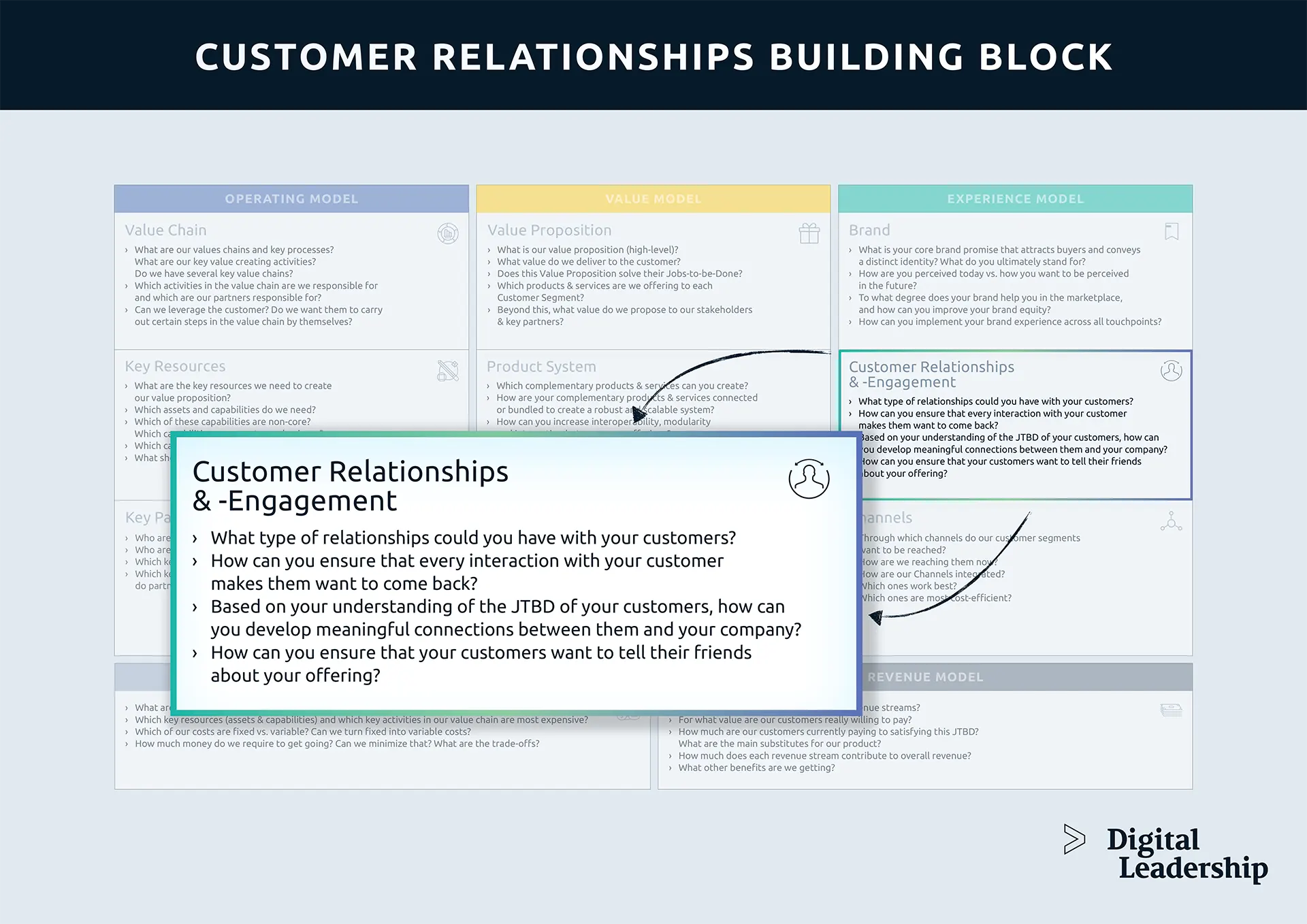
Table of Contents
What are Customer Relationships in a Business Model Canvas?
The Customer Profile section in our business model canvas incorporates principles from neurolinguistic programming and psychological research on motivation and choice architecture. It aims to comprehensively understand the rational and emotional drivers that influence decision-making. Unlike conventional models that rely solely on the “pains” and “gains” dichotomy, this approach recognizes that individuals can be motivated by both positive and negative factors in various ways.
“The UNITE eXtended Business Model Canvas” is a powerful tool that can significantly enhance the efficiency of your overall business strategy, particularly in building strong customer relationships. By utilizing this invaluable asset, you can identify pivotal partners, meticulously assess your cost structure, and refine your value proposition to better meet your customers’ needs. Implementing “The UNITE eXtended Business Model Canvas” can propel your enterprise to the forefront of success by optimizing your approach to customer relations. Download it now to strengthen your bond with customers and drive long-term business growth.
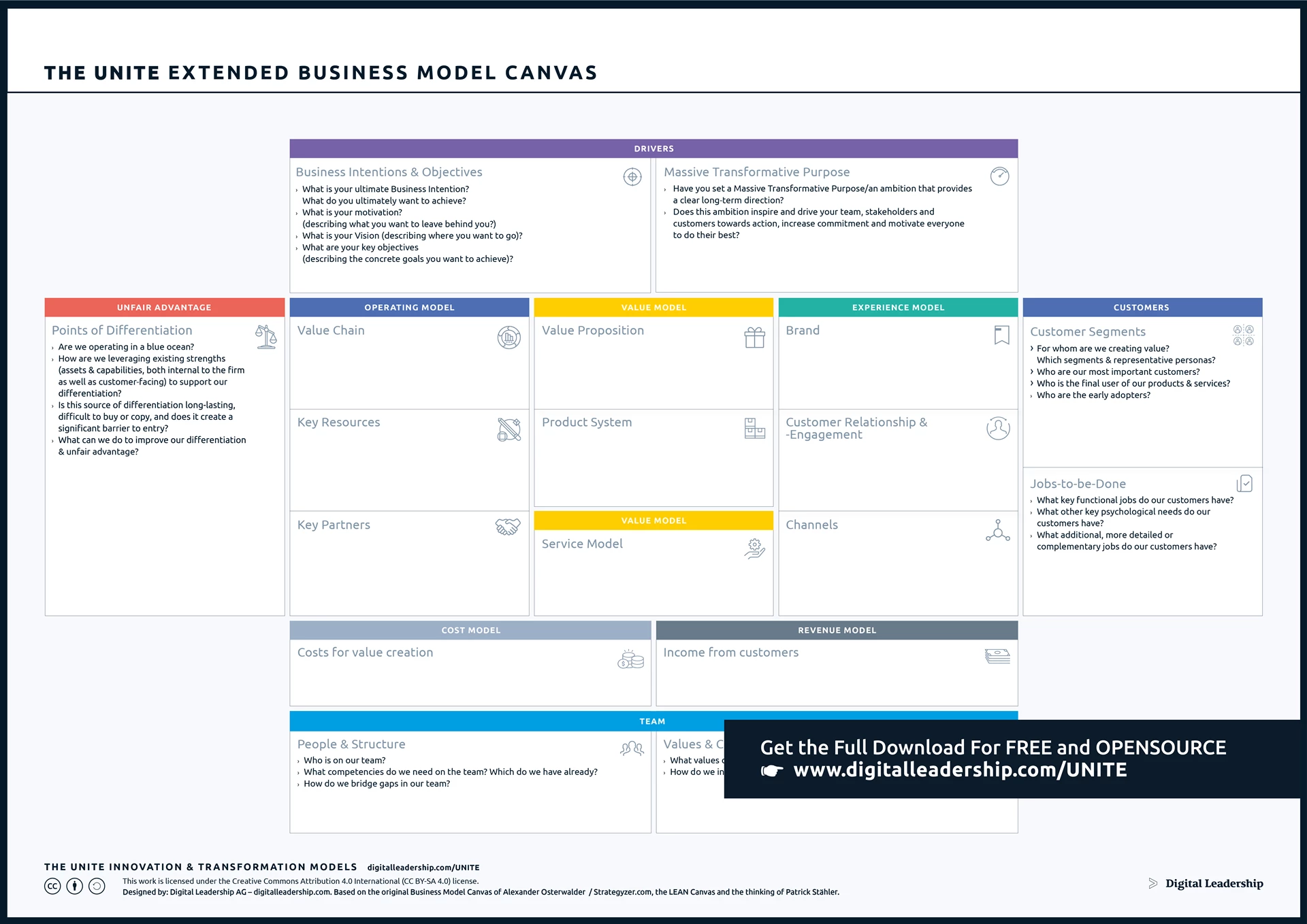
Designed by: Digital Leadership AG – Building on the work of Alexander Osterwalder
Most innovations and businesses struggle to grow. The key to driving growth is to improve solution/market fit (and not just increase the marketing budget!). To improve solution/market fit, organizations need to better understand their customers, which requires a consistent outside-in perspective. Don’t assume you know what your customers’ need is, go out and ask them.
Customer Relationships play a crucial role in the success of a business model as they directly impact customer satisfaction, loyalty, and long-term profitability. At Digital Leadership, our business model strategy service is indispensable for businesses, serving as a definitive roadmap to attain success. Leveraging our expertise, we ensure seamless alignment with organizational goals, foster adaptability to dynamic market conditions, and stimulate innovation for sustained growth.
Identify specific customers by understanding their Jobs to be Done, an important element of the business model canvas. What sort of services do different customer segments expect, and how can you help them complete their Jobs to be Done?
Related: Jobs to be Done Framework, Examples, and Statements (JTBD)
To dig into your Customer needs, work with data-driven Personas. Our book, How to Create Innovation, discusses Personas at length. It’s a system that builds examples, of customers, based on the information you’ve gathered about their habits and identities. Personas help you understand who your customers are as people within their broad segments so you can better reach them and bring them value.
Types of Customer Relationships
We can differentiate how we interact with customers of our businesses, and it’s helpful, too, to consider how we interact with service providers ourselves. It’s not necessary to interact with customers in all the possible ways in order to be successful, and in fact, your business may brag about doing one of them better than all of your competitors. It is necessary, however, to understand what your customers expect when they have contact with you, and make sure you are meeting—and surpassing—those expectations.
| Relationship Type | Description | Example |
|---|---|---|
| Transactional | Minimal or no ongoing connection between the company and the customer. Interactions are limited to specific transactions. | Kiosk at an airport serving customers on a one-off basis. |
| Long-term | Deeper and enduring connection with customers. The company interacts with customers on a recurring basis, fostering loyalty and trust. | Subscription-based services with regular interactions and benefits for long-term customers. |
| Personal Assistance | Based on human interaction, providing customers with assistance during the sales process or post-purchase through various channels like in-person interactions, call centers, emails, etc. Poor customer experiences are often a result of poor personal assistance. | Customer representatives helping buyers choose products and resolve issues. |
| Dedicated Personal Assistance | The most profound relationship, where a specific customer representative is assigned to an individual client. Common in high-end services like a home care provider or a personal shopper. | Personalized financial advisors providing exclusive services to high-value clients. |
| Self-Service | Many successful businesses are built around the self-service concept. Vending machine enterprises and gas stations are good examples of businesses where customers expect to meet their needs with little if any contact from the business owner. In the traditional customer-vendor relationship, for example, if the machines are working properly, the customer will never meet the vendor. | Self-checkout kiosks in retail stores or online platforms for ordering and managing services autonomously. |
| Automated Services | As advancements in robot and AI technologies continue, we can anticipate a rise in truly automated services. A prime illustration of such a business model exists today in the form of automated car washes, where machines handle all tasks, from collecting payments to delivering the service, with minimal human intervention required for servicing and restocking soap. However, it is essential to recognize that even in fully automated processes, the human element remains crucial. Despite businesses revolving around technology and machines, there is still human interaction involved. Whether it’s in the development, maintenance, or customer support aspects, humans play integral roles in ensuring the seamless functioning and success of automated services. | Personalized website content or chatbots providing tailored information to customers. |
| Communities | In certain instances, the relationship between customers and a business is community-based, with numerous online platforms embodying this model. A parallel example of such contact can be seen in visits to places of worship. It’s crucial to recognize that diverse customer segments may perceive the concept of community in distinct ways. The business may act as the provider of the community, or it could be the community itself that actively engages with the business. Positive relationships between the two parties rely on our comprehension of how these transactions and interactions unfold. Understanding the dynamics of this community-based interaction is essential for fostering successful and meaningful connections with customers. | Brands hosting forums where customers interact, share experiences, and provide feedback to each other. |
| Co-Creation | One of the hallmarks of Web 2.0 was the collaborative relationship between service providers and users, who would be responsible for the generation of much of the content found on the Internet. We hardly think twice anymore about a blog post or a Twitter account. As a shift from customer self-service models, co-creation relies on customers to bring much of the value to a business model. In the technology sphere, companies maintain online communities while users exchange knowledge and create value. Businesses rely on users–and content creators–to maintain a personal relationship with other users. Customer relationships are built between the content creator, the platform provider, and the third-party users in a complicated exchange of experiences. Co-creation requires businesses to balance control over the platform and content creation with their customers’ productions in oftentimes difficult ways that we’re still working to understand as a culture. | Crowdsourcing platforms where users contribute to product development or content creation. |
| Switching Costs | Refers to the level of difficulty or ease for a customer to switch to an alternative provider. High switching costs may discourage customers from transitioning to another solution. | Proprietary data format making it challenging for customers to switch to a different data storage provider. |
Related: Introducing the UNITE eXtended Business Model Canvas
Importance of Customer Relationships
The key is to focus not on what you don’t have, but rather on what you do, as a large organization, you have major assets you can use to your advantage. For example, you have a brand, you have existing customer relationships and thus customer access, you have deep technical expertise in specific areas, you have buying power, you have distribution relationships, you possess financial resources, and you probably have a ton of other assets and capabilities.
A start-up has none of these things, nor likely do many of your competitors. These are the things that can form the basis of your own Unfair Advantage if you use them well!
The Unite Value Proposition Canvas, combined with a well-crafted Customer Relationship Business Model Canvas (BMC), plays a pivotal role in the success of a business. By leveraging the major assets and capabilities mentioned earlier, a large organization can create a compelling and differentiated value proposition for its customers. The value proposition defines the unique benefits and value that a business offers to its target customers, setting it apart from competitors. Emphasizing the synergy between the Unite Value Proposition Canvas and the Customer Relationship BMC is essential for any business seeking to thrive in a competitive landscape and deliver exceptional value to its customers. You can download it now.
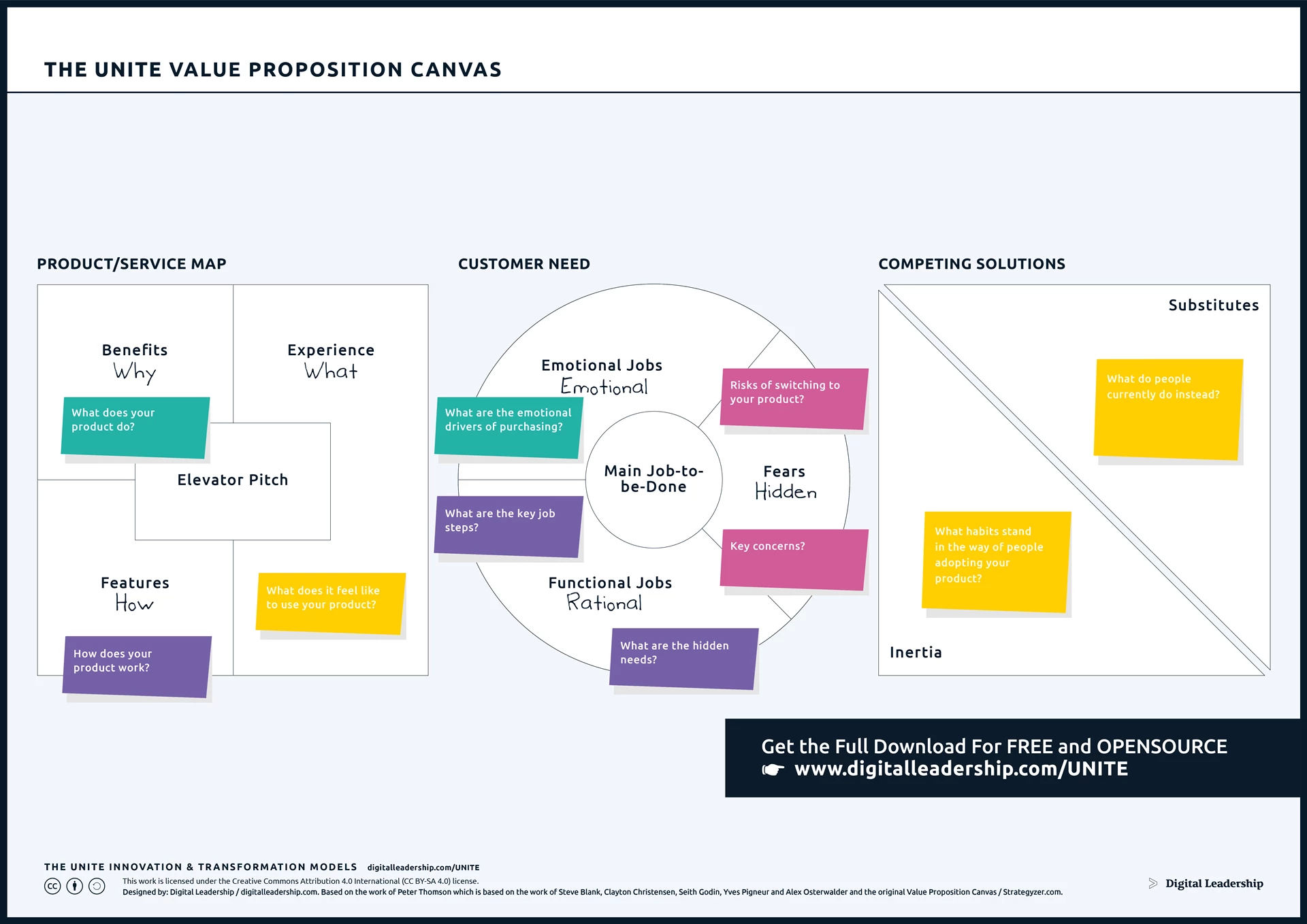
Designed by: Digital Leadership AG – Based on the work of Peter Thomson which is based on the work of Steve Blank, Clayton Christensen, Seith Godin, Yves Pigneur, and Alex Osterwalder
Benefits of Building Positive Customer Relationships
Customer relationships are of paramount importance to any business. Building and maintaining strong customer relationships can have numerous positive impacts on the success and growth of a company. Here are some key reasons why customer relationships are crucial:
1- Customer Loyalty:
- Loyal customers are more likely to stick with the brand and make repeat purchases.
- They often recommend the business to others, attracting new customers through word-of-mouth marketing.
2- Customer Acquisition:
- Building a strong reputation for customer relationships enhances customer acquisition efforts, attracting new customers effortlessly through positive word-of-mouth marketing.
- Positive word-of-mouth marketing generated by loyal customers serves as a powerful tool to attract new customers and increase brand visibility, amplifying the impact of customer acquisition strategies.
3- Customer Retention:
- Prioritizing customer relations is key to fostering customer loyalty and ensuring repeat business, which helps retain customers over the long term.
- A high percentage of repeat customers signifies the effectiveness of customer retention efforts, highlighting the positive impact of building and maintaining strong customer relationships.
4- Customer Feedback:
- Building relationships allows businesses to gain valuable insights through customer feedback.
- Effective feedback collection leads to improved customer satisfaction and loyalty.
5- Brand Reputation:
- Positive customer relationships contribute to a strong brand reputation.
- Businesses known for excellent customer service are likely to attract more customers and gain a competitive advantage.
6- Customer Support and Issue Resolution:
- Strong relationships facilitate better communication with customers.
- Effective issue resolution leads to higher customer satisfaction and improved customer retention.
7- Upselling and Cross-Selling:
- A good relationship opens opportunities for upselling and cross-selling.
- Building trust through positive customer relations makes customers more receptive to additional offerings and upgrades.
8- Customer Experience:
- Positive relationships contribute to an overall positive customer experience.
- Happy customers tend to overlook minor issues and have higher tolerance for occasional mistakes.
9- Long-Term Growth:
- Prioritizing customer relationships contributes to long-term business growth.
- Satisfied customers are more likely to stay with the brand, contribute to its success, and become advocates for the company.
Implications for Businesses in the Customer Relationship Business Model Canvas (BMC):
- Building Customer Loyalty: Prioritizing customer relationships within the BMC leads to increased customer loyalty and retention. Satisfied customers are more likely to stay with the brand, make repeat purchases, and become advocates for the business.
- Word-of-Mouth Marketing: Positive word-of-mouth generated by loyal customers, as highlighted in the BMC, serves as a powerful tool to attract new customers and boost brand reputation. Satisfied customers are more inclined to share their positive experiences with others, expanding the customer base.
- Utilizing Customer Feedback: The BMC emphasizes the importance of customer feedback in understanding customer needs and preferences. Integrating customer feedback into the BMC helps businesses improve products, services, and overall customer experience, enhancing customer satisfaction.
- Data-Driven Decisions: Utilizing data analytics and insights, as mentioned in the BMC, allows businesses to make informed and data-driven decisions. This enhances the customer experience, addresses pain points effectively, and optimizes business strategies.
- Competitive Advantage: The BMC highlights the significance of a positive reputation and strong brand image. Building trust and loyalty through positive customer relationships sets a business apart from competitors, creating a competitive advantage in the market.
- Upselling and Cross-Selling: By focusing on building strong customer relationships in the BMC, businesses can explore upselling and cross-selling opportunities. Trusting relationships make customers more receptive to additional offerings, contributing to revenue growth.
- Enhancing Customer Support: Improving customer support within the BMC enhances the overall customer experience, leading to positive impressions and increased loyalty. Effective issue resolution reduces customer churn and improves retention rates.
- Sustainable Growth: Prioritizing customer relationships in the BMC fosters long-term business growth. Loyal customers, as mentioned in the BMC, contribute to a stable revenue stream, reducing the need for costly customer acquisition strategies.
Digital Leadership Recommendations for Building Positive Customer Relationships
What do good customer relations look like in practice?
It’s easy to claim you have or want to have good customer relations, but in truth, they take investment and consideration. Businesses don’t deliberately abandon beneficial customer relationships, but rather we’ve found the breakdown of customer interactions occurs like a slow-motion car crash that can’t be stopped.
Positive relations also take a plan. Below are some practical steps a business can take to help build positive customer relations.
1) Build Strong Communication
Make sure your internal communication practices are solid. Focus on communicating through as few channels as possible, but use those channels well. With so many options companies can use to monitor workflow and connect with each other, it’s easy for much of it to become distracting noise.
Welcome customers into your communication channels as much as you can. Be honest about availability and response times. Monitor online communities and be certain your company establishes guidelines for public-facing communication.
2) Understand Your Customer Goals
The core purpose of our businesses is to assist customers in achieving their goals. Understanding these goals is crucial for our business success. To gain insights into customer goals, we prioritize open communication. We achieve this by actively engaging with our customers and seeking their feedback. Our customer service team plays a vital role in this process as they are trained to provide personalized assistance, helping us uncover the unique objectives of each client.
We compile this valuable information into individual dossiers for our clients, ensuring a comprehensive understanding of their needs and preferences. This customer-centric approach allows us to tailor our products and services effectively, leading to enhanced customer satisfaction and long-term success.
The Jobs-to-be-Done (JTBD) model is centered around comprehending customers’ fundamental objectives and motivations when using a product or service. The customer job statement defines the specific task or goal that customers aim to achieve, transcending mere product features. This model’s impact is evident in the close relationship between customer retention and relationships. By identifying the customer’s job, businesses can tailor their offerings to precisely meet customer needs, nurturing loyalty. Additionally, strong customer relationships provide valuable insights for aligning products with evolving customer jobs, resulting in heightened satisfaction and increased retention. You can download it now.
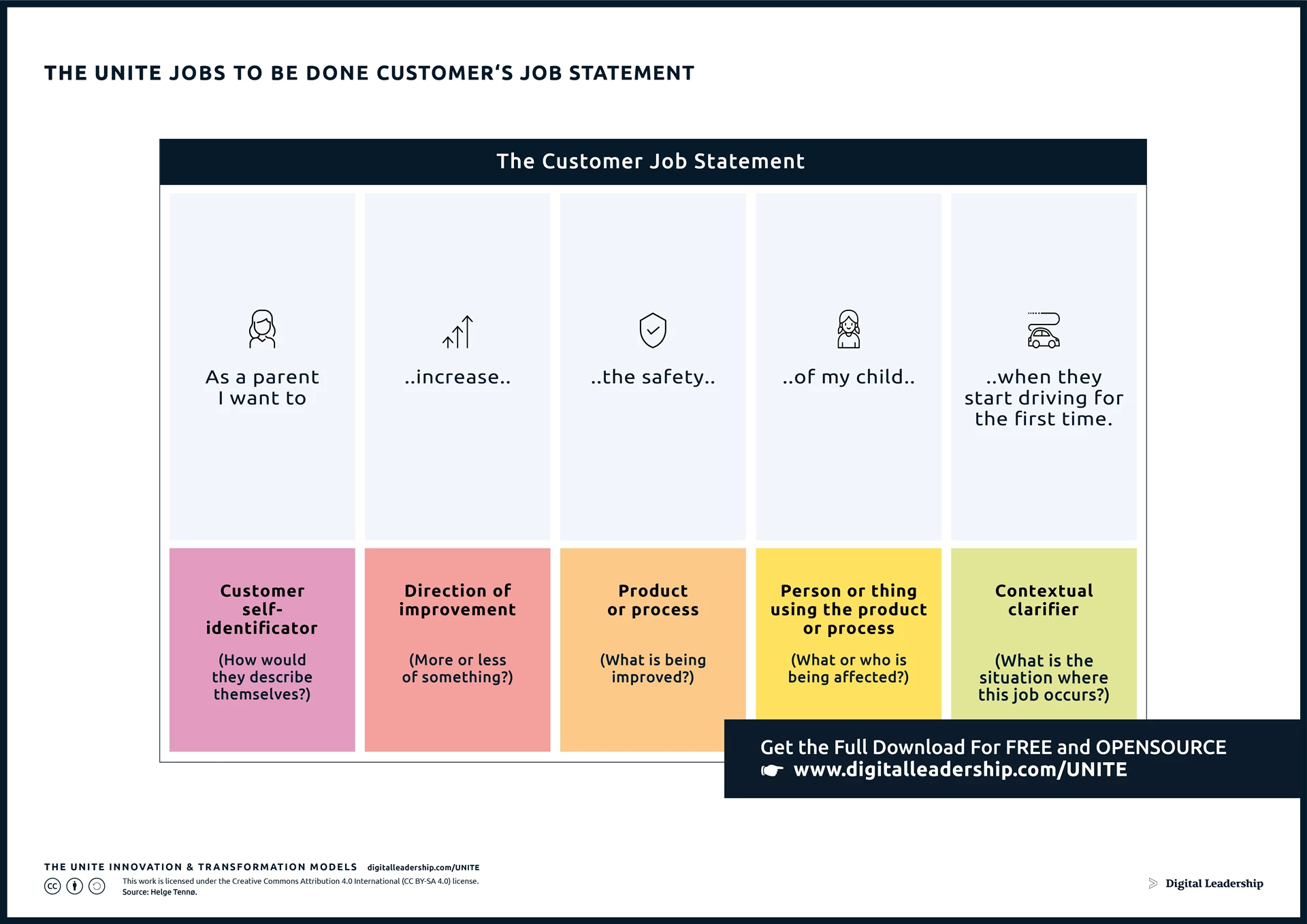
Designed by: Digital Leadership AG – Source: Helge Tennø.
3) Share your Knowledge
What do you know? Who else could benefit from knowing the same things?
Knowledge is rarely a commodity. Rather, the delivery and the execution of knowledge become the cornerstones of our business model. Therefore, you can develop customer relations by sharing your expertise. Through blogs, white papers, social media posts, and other forms of outreach, you can let customers and potential customers share what you know. That builds trust and helps with customer acquisition.
Putting what you know into practice can be monetized. Speaking directly to customers about what you know contributes to building a direct relationship.
4) Treat Clients as Individuals
Consider your experiences as a consumer: what makes you want to frequent your favourite restaurant or store?
Chances are, significant elements of your attraction to these favorites are the personal relationships connected to these places. You’re made to feel important as if your needs are specific to you, and that business is ready to help you navigate your challenges.
Remember that your customers appreciate the same kind of attention. While it’s true that most people can be placed in specific customer segments, no one wants to feel like they’ve been packaged with someone else. Returning customers remain loyal because of how they’re treated. Generous loyalty programs help customers feel seen and may provide your business with unique marketing opportunities.
5) Over Delivering
Efficient customer service includes surpassing customer expectations as a practice, not as a gift.
Support the efforts of your team, to be honest during the sales process so that they aren’t making promises the company can’t keep just to bag a client. Manage customer expectations: let them know what you’ll deliver, how, and when. “Managing” is guiding in this sense, not working to diminish whatever expectations a customer brings to your business.
Focus on providing an excellent customer experience, and make aggressive changes when the experience isn’t meeting expectations. The poor customer experience is your Kryptonite. It will kill your business.
6) Develop Appreciation
Establish a culture that expresses appreciation for the opportunity. No one is entitled to customers; no one is entitled to success.
Customer relationships that are centered on service will appropriately keep appreciation an important element of a business’s practices.
Comprehensive Customer Relationship Strategy: Acquire, Retain, and Grow
The essence of a successful business strategy lies in effectively acquiring, retaining, and growing customers. This comprehensive approach encompasses key elements that are crucial for sustained business growth and profitability.
- Acquiring Customers:
- Developing a clear customer acquisition strategy is essential for attracting new customers to the business. This involves identifying the target audience, understanding their needs and preferences, and crafting compelling value propositions that resonate with potential customers.
- Leveraging various marketing channels, such as digital advertising, social media, content marketing, and traditional advertising, can help reach and engage a broader audience.
- Utilizing data analytics and market research allows businesses to optimize their customer acquisition efforts, ensuring cost-effectiveness and maximizing conversion rates.
- Customer Retention:
- Fostering strong customer relationships and providing exceptional customer experiences are fundamental for customer retention.
- Understanding customers’ ongoing needs and preferences through feedback and interactions allows businesses to continually improve their products and services, enhancing customer satisfaction.
- Implementing loyalty programs, personalized offers, and excellent customer support further encourages customers to remain loyal to the brand.
- Growing Customers:
- Beyond retention, businesses should focus on growing customer lifetime value. By upselling, cross-selling, and offering additional value-added services, businesses can increase revenue from existing customers.
- Identifying opportunities for customer expansion, such as entering new market segments or geographic regions, can lead to further growth.
- Encouraging customer advocacy and word-of-mouth marketing through referral programs and positive customer experiences can attract new customers and accelerate business growth.
Customer Relationship Management importance in Business model canvas
Customer Relationship Management (CRM) is a technological solution that enables businesses to effectively manage and oversee all interactions and relationships with both current and prospective customers. It serves as a centralized system to streamline customer-related activities and improve overall customer engagement and satisfaction. It involves understanding customer needs, preferences, and behaviors to deliver personalized experiences and improve overall customer satisfaction. CRM systems and tools streamline customer interactions, track customer data, and support sales, marketing, and customer support efforts.
CRM in the Business Model Canvas
Integrating CRM practices into the Business Model Canvas enhances the customer relationship component and strengthens other business elements. By aligning customer segments, channels, and value propositions with CRM data, businesses can create more focused and customer-centric strategies.
Benefits of CRM in the BMC:
- Improved Customer Understanding: CRM enables businesses to collect and analyze customer data, gaining valuable insights into their preferences, pain points, and expectations.
- Personalized Customer Experiences: By leveraging CRM data, businesses can tailor their products, services, and marketing efforts to meet individual customer needs, fostering loyalty.
- Enhanced Customer Satisfaction: CRM facilitates efficient customer support and issue resolution, leading to higher customer satisfaction and retention rates.
- Streamlined Sales and Marketing Efforts: CRM systems help businesses track leads, sales, and marketing campaigns, optimizing customer acquisition and conversion rates.
- Sustainable Competitive Advantage: Effective CRM integration allows businesses to build strong customer relationships, differentiating them from competitors and creating long-term value.
Conclusion
Customer relationships play a pivotal role in the success of any business, and the Business Model Canvas provides a comprehensive framework to understand and optimize these relationships. By identifying the specific tasks or goals customers aim to achieve, businesses can tailor their offerings and value propositions to meet their needs effectively. Whether through transactional interactions, long-term relationships, personalized assistance, or co-creation, understanding and meeting customer expectations are essential for fostering loyalty and retention. By implementing the digital leadership recommendations and prioritizing customer-centric approaches, businesses can build trust, loyalty, and lasting connections with their customers, driving long-term growth and sustainable success in today’s dynamic market environment.
Frequently Asked Questions
1- What is an example of a customer relationship?
An example of a customer relationship can be observed in a subscription-based streaming service like “StreamFlix.” It maintains a strong customer relationship by providing personalized content recommendations based on each user’s viewing history and preferences. Through regular communication via email newsletters, they offer special discounts, exclusive previews of upcoming shows, and early access to new releases, making their customers feel valued and appreciated.
Moreover, StreamFlix actively interacts with its audience on social media, responding to comments and inquiries promptly, creating a sense of community among its subscribers. They also have a loyalty program where long-term subscribers receive additional benefits and rewards, incentivizing customer retention and encouraging customers to remain loyal to the platform.
2- How do I build customer relationships?
A: Building customer relationships involves various strategies, such as actively engaging with customers to understand their needs, providing personalized assistance, offering exceptional customer experiences, collecting and acting upon customer feedback, and creating loyalty programs with exclusive benefits.
3- What is customer relationship management?
Customer Relationship Management (CRM) refers to the practices, strategies, and technologies that businesses use to manage and analyze customer interactions throughout the customer life cycle. CRM aims to improve customer relationships, enhance customer satisfaction, and drive customer loyalty by understanding customer needs and preferences.
Connecting The Dots: The UNITE Business Model Framework
How to Create Innovation includes a number of canvases that focus on value creation and finding the right business model to meet your customer segment and customer needs. The framework is built to inspire drastic changes that help you find a competitive advantage. Our hope is that your company grows through business model innovation, and so we again encourage you to look deeper into our website and the book.
Here is a summary of the key ingredients of the framework:

Designed By: Digital Leadership AG
Business Models
The centerpiece is the Business Model Canvas, which covers the six main areas of a Business Model (the Operating, Value, Service, Experience, Cost, and Revenue Models).
The eXtended Business Model Canvas adds the immediate business context, including Business Drivers, customers, and the team, as well as the Unfair Advantage.
Detailed Models
A Business Model can be broken out into its numerous aspects. Depending on what challenges you face, you can zoom in on your area of interest using an appropriate tool or canvas:
- Your Business Intention and objectives as well as your Massive Transformative Purpose summarize your drivers and give direction to what you do.
- The Value Proposition Canvas details the central components of your offering (the product or service).
- To dig into your Customer Segments, work with data-driven Personas.
- The JTBD Customer Job Statement and Job Map frame the JTBD of your customers.
- The Business Model Environment puts your Business Model in a market context composed of emerging trends and disruptive forces.
- The Innovation Culture Canvas helps you understand and consciously shape a culture that supports innovation.
- The Innovation team structure enables you to draft a team structure for your innovation initiative.
- Using learning and growth metrics, you can measure progress at the initial stages of development. These metrics help you focus on what really matters instead of creating a detailed business plan that will not really help you. Later on, you can expand the financial aspect of the Revenue and Cost Models with a full business case.
- The Operating Model Canvas helps you think through the Operating Model.



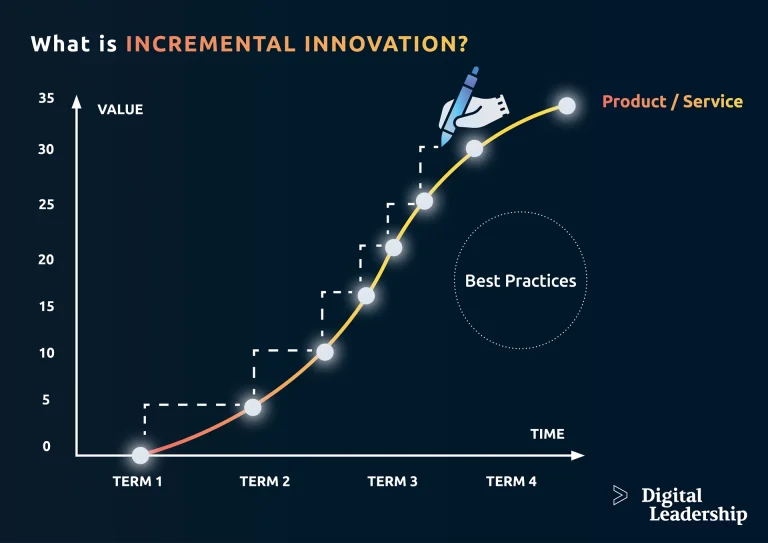





























 Book How to Create Innovation
Book How to Create Innovation